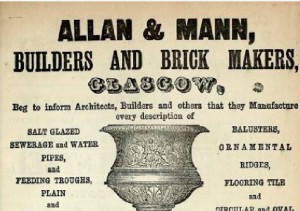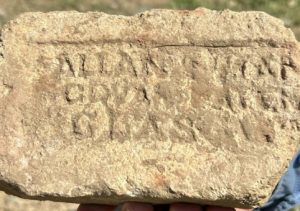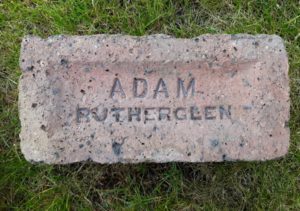Allan & Mann, Port Eglinton, Glasgow.
Alternative brickworks include:
- Rutherglen Pottery, Glasgow.
- Mallsmire Works, Myrtle Park, Crosshill, Glasgow.
Canmore
1837 – The 1985 publication ‘A survey of Scottish brickmarks’ suggests that Allan and Mann were operating the works from 1837.
1840 – 1841 – David Baird, brickmaker at Allan & Mann – Ho, 181 Eglinton Street.
1841 – 1842 – Allan & Mann, common and fire brick and tile makers, Port Eglinton p25.
1843 – 1844 – Allan & Mann, Common and fire brick and tile makers, Port Eglinton.
18/10/1845 – The Scotsman – Fatal accident. About four o’clock on Thursday morning a stranger met his death at the brick kilns of Messrs Allan & Mann situated at Port Eglinton, Gorbals, Glasgow. He had gone in to warm himself when a large quantity of bricks suddenly gave way and he was buried under the mass. Every exertion was made by the workmen to extricate the unfortunate man but by the time the body was recovered, life was extinct. The affection of the stranger’s dog was touchingly manifested in using every effort to aid the workmen to uncover the body of its unfortunate master and it could only be removed from the spot by force. The deceased was apparently about 25 years of age was decently dressed in moleskin clothes and had 9s 9d in his pockets. . He is believed to have been a carter who had arrived from Edinburgh by one of the canal boats on his way to be employed near Barrhead. The body was brought to the Gorbals Police Office where it lies unclaimed.
Below – 20/09/1847 – Glasgow Herald – Sale at Messrs Allan & Manns Brickfield, Bryceland on the road leading to Pollokshaws and a short distance from the south end of Main Street, Gorbals.

1849 – 1850 – Allan and Mann, common and fire brick makers, Port Eglinton.
Below – 1850 – Report on the Geology of Alabama – p115 – Possibly Allan & Mann bricks.

1852 – The Lost Gardens of Glasgow University by Arthur Donald Boney, 1988. – In July 1852 Messrs Allan & Mann, brickmakers, offered Faculty £300 per annum for the lease of the ‘upper green of the Observatory Park (Glasgow) for working out the clay contained in it for a limited number of years.’
1852 – 1853 – Allan & Mann, brick makers, Port Eglinton, Glasgow.
1853 – 1854 – Allan & Mann, brick, drain-tile, petrified pipe manufacturer and builders, Port-Eglinton Brickworks, Canal street.
31/10/1855 – Glasgow Herald – Found three sheep. The owner may have them by proving his property and paying expenses. If not claimed within six days from this date, they will be sold or otherwise disposed of to defray expenses. Apply to Mr Lockerbie, Port-Eglinton Brickworks, Glasgow. 30th October 1855.
Below – 1858 – Port Eglinton Foundry. There is a brickfield marked at the top centre of the map, at the end of Canal Street. There is a reference to drying sheds and kiln which I assume is the brickworks location.

1858 – 1861 – ScotlandsPlaces – Brickworks near Falfield Mill, A Bow Esqr. A group of buildings comprising Engine House, Drying Shed, [kiln?] with a large Brickfield [–]
The property of A & T [Bow?] (Note – SBH – This is confusing. The Shields Bridge Brickworks on the 1858 map are on the west of the railway but the location of the works described here by ScotlandPlaces are on the east of the railway which were worked by Allan and Mann. It is possible of course, that in c. 1858 the works changed hands from Allan and Mann to A & T Bow).
1860 – 1861 – Allan & Mann, builders and manufacturers of common and fire bricks, tiles, vitrified pipes, and other fire clay goods, Rutherglen Pottery; office, 48 St. Enoch square.
Below – 1861 – Advert Allan & Mann Glasgow.

1862 – 1863 – James Thomson, manager for Allan & Mann; ho. 22 Canal Street, Port-Eglinton.
Below- 21/09/1863 – Northern Whig – W. D. Henderson, Belfast agents for Garnkirk, Allan & Mann and J & M Craig.

04/07/1865 – Belfast News – Scotch Fireclay goods – Scottish fire clay goods. Builders, contractors, &c., will find the largest and most varied stock of the above goods kept in Ireland at my depots – Queens Quay, Belfast and 56, North Wall, Dublin.
The Goods are second to none in the market and at lowest rates, white bricks (extra finished), for Facing, Buildings, in great variety. Also, glazed sewerage pipes, with patent or socket joints. Robert Brown.
Belfast Depot-Queens Quay. Dublin Depot – 56 North Wall Works, Paisley. N.B.- Goods can be sent to any Port in Ireland, either by sailing vessel or steamer, direct from the works. 4235.
The subscribers have for sale:- Garnkirk fire brick and clay; Allan & Mann’s white building brick (the best brick manufactured); J. & M. Craig’s Brick, 1st and 2nd qualities; Do, white and red glazed tiles; Sealy’s Bridgewater Tiles and Bath brick; Staffordshire Black Brick, various shapes; Chester tiles and brick;
Architectural Pottery Company’s ornamental tiles; cements, London, Portland, Roman; Hydraulic limes, &c.; Chimney cans, water pipes, &c., &c., &c.
W.D.Henderson & Sons. Office-14 Corporation Street. Yard – Albert Square. 4113.
01/08/1867 – The Dublin Builder – White brick – The subscribers, as agents for Ireland for Messrs Allan & Mann of Glasgow, would invite the attention of Architects and builders to the unrivalled brick manufactured by this firm. These are in every respect superior to any other white brick manufactured. Sample boxes and price lists will be sent free on application. W.D Henderson & Sons, Insurance Buildings, Victoria Street, Belfast.
1868 – 1869 – Allan, Hugh (of Allan & Mann), house, 3 Argyle Terrace, Crossbill.
Allan & Mann, builders and contractors, manufacturers of common and fire bricks, tiles, and fireclay goods; depot. Canal Street, Port-Eglinton; office, 48 St. Enoch square.
1869 – Allan & Mann, 22 Canal Street, Port Eglinton, Glasgow. Office St Enoch Sq.
24/11/1869 – The Glasgow Herald – Court of Session Allan & Mann V Dixon’s Trustees.

.
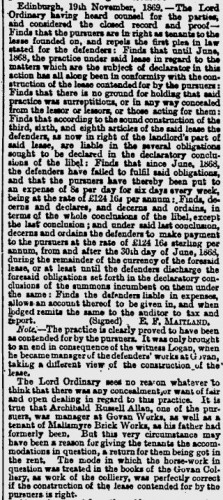
.

Below – 29/06/1870 – Northern Whig. Allan & Mann advert.
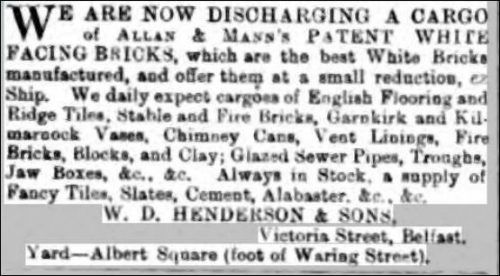
29/07/1870 – Greenock Telegraph – To builders – Daniel Devlin, in continuing the business carried out by Allan & Mann at 11 Patrick Street begs to intimate that he now has on hand a large and well-selected stock of Caithness and Arbroath pavement, drain pipes, chimney cans, ornamental bricks and fire clay goods of every description. Portland and Roman cements, Arden Lime etc – 11 Patrick Street, Greenock. July 1870.
1870 – 1871 – Hugh Allan (of Allan & Mann), house, 3 Argyle Terrace, Crosshill.
19/10/1872 – Glasgow Herald – Hugh Allan, brick manufacturer residing at 3 Argyll Terrace, Crosshill to be examined within the Sheriff Courthouse, Paisley 28th October at eleven o’clock. Creditors to meet within the chambers of Messrs Moore and Brown, chartered accountants, Glasgow on 7th November at two o’clock.
29/10/1872 – Glasgow Herald – Yesterday, before Sheriff Cowan, Hugh Allan, sometimes brick manufacturer at Crosshill, Renfrewshire was examined in bankruptcy. The sederunt comprised Wm. Brown, C.A., Glasgow, the trustee; Jas. H. Dunn, writer, Paisley; Thomas J. Smillie, writer, Glasgow, law agents in the sequestration; Andrew Thomson, grocer and wine merchant, Glasgow, a creditor and Robert D. Macfarlane, writer, Glasgow, agent for Thomas Henderby, flesher, Glasgow, a creditor.
The bankrupt deponed. I am 59 years of age. I commenced business on or about 12th February 1861, shortly after my father’s death. I had been previous to that date in the employment of my father. My partners were my brothers David, James and Archibald Russell Allan. Our business consisted of the manufacture of common bricks, white bricks, fire bricks, glazed pipes and building and contracting. At that date, we continued in our own names the business which had previously been conducted by our father for some time before his death by himself alone and in the partnership with the late Mr John Mann. John Mann died a good number of years prior to 1861 and from the date of his death, the business had belonged to my father. The salary which I had received from my father was £90 per annum for several years prior to his death. In addition to the above sum, my father provided me with a free house and coal. My brothers and I had no written contact of copartnery. We did not succeed in adjusting terms. I considered the terms proposed on my brother’s behalf to be too favourable for them. I insisted upon a condition that I should have £300 per annum salary as the managing partner before a division of profits was made. My brothers repudiated such a condition. In my opinion that was a fair and reasonable allowance for my services. My brother David did not at any time take part in conducting our business. He was for some time an invalid and otherwise he was engaged with Mr Dixon of Govan Colliery. James took charge of the pottery department at Rutherglen chiefly and he took a general charge of the machinery. I considered that Archibald Russell Allan took no part in the management of the business. He succeeded my brother David as manager to Mr Dixon and I believe his time was fully occupied with his duties as colliery manager to Mr Dixon of Govan. He left that situation shortly before our partnership was dissolved. There was no provision or agreement between my brothers and myself when we commenced business together as to the amount of our drawings from the business from time to time. I continued to draw from the business such sums as I required just as I had done during my father’s life. There was a cashier who kept the books of our firm and all my drawings were regularly entered by him. I have been married for nearly 30 years and have a family of twelve of whom two are dead. During the period of our partnership, I was engaged in no speculations on my own account nor was I engaged in any other business. I had no other source of income than the drawings from our business. I expended the whole of my drawings on my family in maintaining and educating them. I cannot at present moment give the exact average expenditure from year to year but on looking at a statement of my drawings see that from 1861 to 1864 my average would be £400 per annum and from 1864 to 1869 about £700 per annum. The public books of the firm were balanced annually, but these did not show the state of the partners accounts nor the capital account. These books showed all my drawings, and for a certain period, I think, also the drawings of my brother James; but the drawings of my brother Archibald, if he made any drawings were not shown in the books. For nearly 40 years our business was conducted under the name of Allan & Mann. Prior to my father’s death, David Lockerby was the manager and I kept the books and took a general management of the business in concert with Mr Lockerby. who knew certain matters connected with the building department better than I did and I knew other matters connected with the manufactory better than he did. In any new affair or difficulty we consulted Mr Mann or my father but neither of them took the immediate oversight of the business. After my father’s death I considered myself the acting manager of the business. Our firm was dissolved on account of the interference of my brother Archibald. He said that I was extravagant and from other remarks which he made we considered it better to dissolve our business connection. A minute of dissolution was signed on 11th November 1869 and upon a strict accounting under the partnership it was alleged by my brothers that I was indebted to the partnership in a large amount. I was summoned by them and stated defences to that action but acting under the advice of my counsel and agents, the action was compromised. I was unable to be the amount which was found to be due and I have not paid it yet. I assigned to my brothers in security of the due payment of that debt the reversion of my house at Crosshill and my interest in my father’s estate and in that of my brother David, shortly after the settlement of that action. It was decidedly part of the arrangement and for settlement of the action that I should so assign my interests in these estates. Under my father’s settlement have an interest along with my brothers and sisters and I have also an interest in the estate of my brother David and I also have an interest in my mother’s estate under her settlement. I could not at present definitely state the precise value of my interest in any of these estates. The state of affairs submitted by me to the first meeting of creditors is accurate to the best of my knowledge and belief. I believe I have given to my trustee all the information in my power concerning my estate.
Examined by Mr McFarlane – I think a proposal was made on the death of my father by some of the trustees to my brother and myself to the effect that we should take over the business of Allan & Mann of which the testator was the sole partner. As near as I can remember we were to pay the sum of £10,000 for the business. At the date of my father’s death in 1961, I was indebted to him for upwards of £550. At the date of my father’s death, I was possessed of no estate or property whatever except my household furniture which might then have been worth £100. I have no recollection of my brothers and myself granting any document of debt for the £10,000 and I am not aware whether any document was granted by Allan & Mann. At the date of the dissolution of the partnership between my brother and myself the accounts made out by Mr Hutton, the liquidator showed that I was largely indebted to the firm and I was not possessed of any means to buy over the business. The business was disposed of under the liquidation, in terms of articles of roup, whereby it was provided ?” that it was to be a sale by auction among Hugh Allan, James Allan and Archibald Russell Allan”. Interrogated – Seeing you were not possessed of means to purchase the business why did you not insist upon the sale being made by public auction. Depones – I did so under the advice of my agents Messrs McGrigor, Stevenson and Fleming. My brothers were the only partners who had the opportunity and were able to purchase the business. They did purchase the business at the upset price of £4500. The dissolution of the firm, as far as I know, was not advertised in the gazette or notified to the customers of the firm to my knowledge. Interrogated – Why did you grant an assignation of your estates, excluding the household furniture, in favour of your brothers when you had creditors. Depones – I did it under the advice of my counsel and also because my brothers had arrested, on the dependence of the action, my interest in the above estates. How do you account for the great increase in your drawings from £300 in 1861 to £1000 in 1868? Depones -I considered that I had a right to it and I expended it on my family and in repairing my house and in purchasing additional furniture. My mother’s income might safely be set down at £900 per annum. I could not say whether my mother expended that amount yearly but I received no portion of it nor any assistance from her. I am quite in the dark regarding the amount left by my mother. Since the dissolution of our partnership, my brothers have paid the executors of my late father the debt due to the estate for the price of the business being about £10,000 as above explained. I know this as one of the trustees of my late father. My brothers assigned to one of the banks in Glasgow their interest in my father’s estate and my impression is that they on the security thereof obtained the means to pay the trustees the said £10,000 and the assignation was intimated to my father’s trustees. The law agent, Mr J. M. Roberston, I think will have a copy. The diet was adjourned.
1880 – 1885 – Invoices numerous – Allan and Mann, builders and manufacturers of composition and fire bricks, tiles, vitrified pipes &c, patent pressed machine and hollow common bricks, roof ridge, drain and floor tiles, fire covers, gas retorts, grate backs, vases, chimney cans, cow troughs, wall copes. Office – 48 St Enoch Square, Glasgow.
1882 – Allan & Mann, Brickmakers, Rutherglen.
Brickfrog Info

